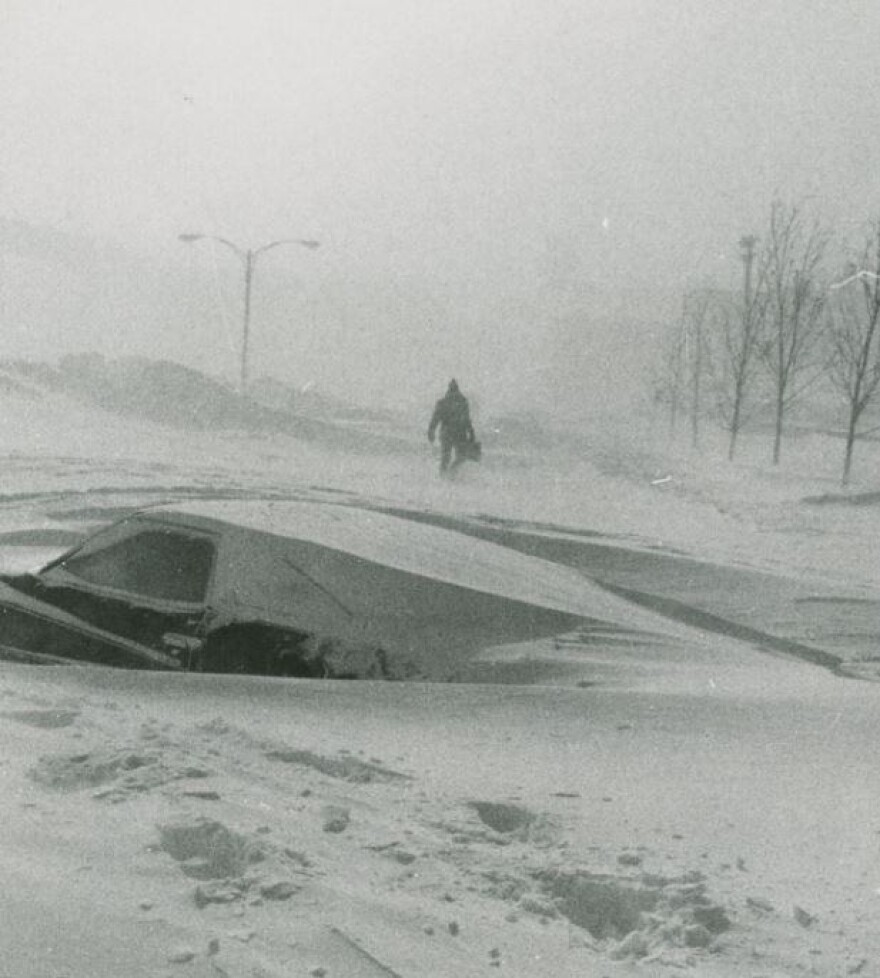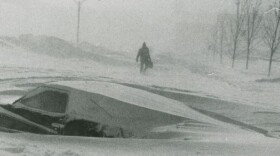It was 40 years ago this weekend when the infamous Blizzard of '77 blew through Western New York, leaving snow drifts several feet high in places, cars buried, many roads impassable for days and 23 people dead in the Buffalo area alone. Two of the Buffalo weather broadcasters who worked during the blizzard looked back on the storm that still has many thinking of the region as a snow capital.
The storm began on January 28, 1977 and continued through February 1. During those dates, the National Weather Services in Buffalo recorded winds ranging from 46 to 69 miles per hour.
Meanwhile, on the frozen surface of Lake Erie, there was snow. Plenty of it. And the blizzard winds picked it up and pushed it into Western New York, causing the drifts and piles that left countless people stuck in their homes or offices or, worse, in their cars.
Kevin O'Connell, currently WGRZ-TV's senior weather anchor, was working for Channel 4 in Buffalo, which then went by the call letters WBEN-TV. He recalled staying at his station on Elmwood Avenue for four days. Like the other television forecasters in that era, O'Connell was challenged with keeping viewers updated on the latest storm conditions without some of the technology many take for granted today.
"I think we were almost hooked at the hip to the professionals at the National Weather Service, who did have the best radar in the area and has even improved for them over the years," O'Connell said. "What we had was just a huge windstorm."
Although the images from 1977 might suggest otherwise, only 12 inches of new snow were officially recorded among the massive accumulation that blew in off Lake Erie.
Tom Jolls, who was part of WKBW-TV's legendary broadcast trio, along with news anchor Irv Weinstein and sports anchor Rick Azar, wasn't sure if he'd even make it into his station. Luckily, he explained, his son Dale had recently purchased a four-wheel-drive vehicle and offered to give his dad a ride. They also picked up Azar, who had lived about four to five miles from Jolls' home.
"Rick called the Amherst Police and they were kind enough to drop Rick off at my house," Jolls explained. "Then my son took us to work."
Their workplace was then located on the 1400 block of Main Street. When Jolls stepped outside to do a segment, he got to see the severity of the storm and its impact on travel.
"An ambulance went by on Main Street, crawling. Literally crawling," he recalled. "The siren was blaring away. I thought to myself, and I said on the air, pity the poor people that have to rely on an ambulance tonight. Fortunately they were on the move and going to get stuck, so that probably was a godsend for them."
It took days for some streets to be cleared and reopened to traffic. President Jimmy Carter had declared all of Western New York a federal disaster area. Yet amidst the crisis, O'Connell says, the region renewed its role as the "City of Good Neighbors," with people checking up on neighbors, especially seniors and shut-ins, and working together on the daunting task of digging out.
He told WBFO while the Blizzard of '77 gave the region its reputation for being a snow hub, in spite of locations like Syracuse recording higher snowfall totals in subsequent years, what Buffalo should also be remembered for was how the community came together amidst the crisis.
"Hopefully everybody that sees us as the blizzard capital of the world also sees us as one of the most compassionate, helping and strong communities, when it comes to community spirit," O'Connell said. "We define what being a community activist is all about."
There have been numerous major storms since the Blizzard of '77. There were blizzards in 1985 and 1993 and more recently the infamous "Snowvember" of November 2014 (also nicknamed "Winter Storm Knife" by the Erie County Executive's office), the latter of which saw several feet of lake effect snow fall on parts of the region including South Buffalo and southern suburbs.
However, Jolls still considers the Blizzard of '77 the granddaddy of Buffalo's storms. It was the storm that taught people, once technology improved and more advanced warnings were feasible, to prepare with food and supplies. He also noted that in addition to the snow and wind, the storm in January 1977 brought frigid and deadly temperatures into the region.
"I think that was more of a problem in many instances, as far as the fatalities went, than the actual snow itself," Jolls said. "That was something the human body just wasn't ready to accept and be able to accommodate."
O'Connell recalled when he could finally return home to his family, which included a young son.
"When I got home after four days - one of our camera crews took me in one of the news cruisers - I stopped an picked up a couple of sandwiches at a nearby deli that happened to be open," he said. "The first thing he said when I walked in the front door was 'fresh food!' Not 'hi dad,' but 'fresh food, fresh food!'"
Jolls looked back on the experience of working during the Blizzard of '77 with pride but is satisfied to leave it in the past.
"It was an experience I was glad to have gone through, but I never would want to do it again."




